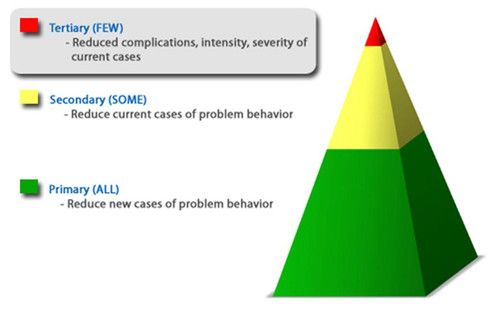
Tier 3 focuses on the individual behavior of the remaining 5-10% of students who are not responding to the Universal and tier 2 Systems of Support. These students are experiencing a life crisis or have developed chronic problem behaviors. Tier 3 behavioral interventions include wraparound planning.
Wraparound planning is a process based on student and family strengths as well as needs across the home, school, and community. Interventions may extend beyond the structured school day.

The 5-10% of students who need intensive Tier 3 Interventions and Supports are identified by the building team. There is no set criterion but the following needs are considered:
The Tier 3 intervention widely used is Wraparound. The Wraparound process is based on individualized, needs-driven planning and services. It is not a program or type of service. An individualized plan is developed by a Child and Family Team, consisting of people who know the student best.
The four phases of Wraparound:
The first phase of Wraparound focuses on team development. A facilitator (or co-facilitators) is selected for the team.The goals of Phase I are to:
Family engagement is crucial in the Wraparound process. The family’s voice leads the team, giving the family ownership of the process. The development of the Child and Family Team is based on the family’s supports, focusing on individual’s role with the family.
Phase II of the Wraparound process focuses on developing team ‘culture’ and collaborative team building.The goals of Phase II are to:
Phase III of the Wraparound process focuses on modifying, adapting, and adjusting team plans in order to reach the ‘Big Need.’
The goals of Phase III are to:
Phase IV of the Wraparound process focuses on maintaining positive outcomes related to the ‘Big Needs.’The goals of Phase IV are to:
Tier 3 Interventions and Supports are effective for 1-2% of those students receiving tier three services. Despite the intensive level of support that Tier 3 provides, some students will still need additional services to encourage positive behavior and school success.
The Wraparound process is monitored with specific perception data tools that measure success of the individualized plan and whether or not the ‘Big Need’ is being met and the student’s quality of life is improving.
For details about how Tier 3 Tertiary Interventions and Supports looks in each implementing school, refer to the PBIS link for the school.